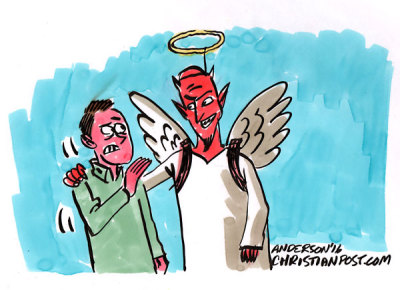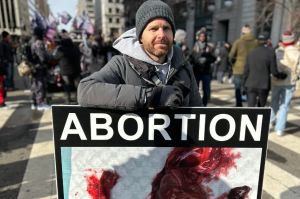Revelation 17: Imitation, deception and the ultimate triumph

Han Van Meegeren, a Dutch artist and art forger, is said to have duped buyers out of as much as $30 million. He gained notoriety for his forgeries during and after World War II. When the war ended, Van Meegeren was arrested for selling cultural property to the Nazis. More specifically, he was charged with selling a painting to Reichsmarschall Hermann Göring, one of the most powerful figures in Nazi Germany. The painting was believed to have been one of Johannes Vermeer’s works. However, facing the possibility of execution for his crime, Van Meegeren admitted that the painting he sold to Göring was a fake that he had painted.
Van Meegeren’s forgeries were driven by a desire for revenge against art critics who disparaged his original works. He wanted to prove he was equal to the Old Masters of the Dutch Golden Age. His paintings looked so much like what the Masters had done, they fooled the best experts and collectors into believing what he possessed were genuine 17th century works of art. But they weren’t. Instead, they were counterfeits. Van Meegeren was only a Master of imitation, and not himself a master.
One of Satan’s greatest devices for deceiving and destroying people is imitation. There are many notable instances of this throughout the Bible.
In the Old Testament, when Moses’ staff became a serpent, demonstrating the power of God, Satan enabled Pharaoh’s magicians to imitate the miracle (Exodus 7:8-13). Whenever God would send his prophets to his people to warn them, Satan would send his prophets to counter their message (Jeremiah 23:16-17; Micah 3:5-8).
In addition to Satan raising false prophets in the Old Testament, in the New Testament Jesus warned of false messiahs who would come and deceive many (Matthew 24:24). These individuals would claim to be the Messiah or the Christ, impersonating the One and only Savior of the world, the Lord Jesus. Jesus said there would also be false signs and wonders performed by these counterfeit religious leaders. These miracles would be so cunning and appealing, that if it were possible, they would even fool the elect.
The apostle Paul solemnly warned of a counterfeit spirituality, when false apostles, deceitful religious workers, masquerade as apostles of Christ (2 Corinthians 11:13-15). He also wrote in his letter to young Timothy to turn away from hypocritical teachers who communicate “doctrines of demons” and misrepresent the clear teachings of the Word of God (I Timothy 4:1).
The apostle James cautioned about counterfeit religion. He said counterfeit religion says you can say that you believe in God, but if your profession of faith isn’t validated by a transformed life and proved by such behaviors as controlling your speech and helping your fellow man, then you are only fooling yourself (James 1:26-27).
In the Book of Revelation, there are similar contrasts made between what is genuine and what is forged, which present dualities or opposing forces.
Perhaps one of the central dualities in Revelation is the Lamb and the beast, both are presented as Saviors, but only Christ, the Lamb, is the true Savior, while the beast is an imitator, an imposter, who is in opposition to God.
The seven churches are addressed, and among them are those with a reputation for being alive, but are dead (Revelation 3:1). This represents congregations that have an appearance of godliness, but are really spiritually lifeless, counterfeit, and produce no fruit for God.
The dragon is first introduced in Revelation chapter 12, the beast is first seen in chapter 11, and the false prophet is first presented in chapter 13. This unholy trinity is the devil’s imitation, a counterfeit of God’s Holy Trinity, the Father, the Son, and the Holy Spirit, all of which have a blessed role in salvation. The dragon, the beast, and the false prophet lead humanity into Hell.
According to chapters 17 and 18, God has a seal to identify those who trust in Him, and the beast imitates this action with his own mark that identifies those who trust in him.
Revelation chapters 19 and 21 reference the true Church, the Bride of Christ, as a city, the New Jerusalem, the Holy City. The harlot woman of Revelation chapters 17 and 18 is the devil’s imitation of God’s people, in alliance with the beast, which is also called a city, Greater Babylon. She is a spiritual fornicator who rides atop a worldwide government, reigning over the kings of the earth and forcing the people of God underground.
In the first six verses of Revelation chapter 17, an angel takes John to witness the judgment of the great spiritual whore. She represents the adulteration of God’s truth. She embodies the false religious systems throughout history that have joined with political structures. She is depicted in the last days as sitting on a scarlet beast with seven heads and ten horns and bearing blasphemous inscriptions. She is adorned with opulence and holds a golden goblet filled with moral decadence. Her forehead bears a name: “Babylon the Great, Mother of all Prostitutes and Obscenities in the World.” Lastly, she is a bloody persecutor of those who genuinely know God and walk in fellowship with him.
When shown this, the apostle John is flabbergasted by what he has witnessed. He is astonished at how effective the devil has been in obfuscating the truth with misleading imitations of the divine.
Here is the remainder of Revelation chapter 17. It says:
“Why are you so amazed?” the angel asked. “I will tell you the mystery of this woman and of the beast with seven heads and ten horns on which she sits. The beast you saw was once alive but isn’t now. And yet he will soon come up out of the bottomless pit[ and go to eternal destruction. And the people who belong to this world, whose names were not written in the Book of Life before the world was made, will be amazed at the reappearance of this beast who had died.
“This calls for a mind with understanding: The seven heads of the beast represent the seven hills where the woman rules. They also represent seven kings. Five kings have already fallen, the sixth now reigns, and the seventh is yet to come, but his reign will be brief.
“The scarlet beast that was, but is no longer, is the eighth king. He is like the other seven, and he, too, is headed for destruction. The 10 horns of the beast are 10 kings who have not yet risen to power. They will be appointed to their kingdoms for one brief moment to reign with the beast. They will all agree to give him their power and authority. Together they will go to war against the Lamb, but the Lamb will defeat them because he is Lord of all lords and King of all kings. And his called and chosen and faithful ones will be with him.”
Then the angel said to me, “The waters where the prostitute is ruling represent masses of people of every nation and language. The scarlet beast and his ten horns all hate the prostitute. They will strip her naked, eat her flesh, and burn her remains with fire. For God has put a plan into their minds, a plan that will carry out his purposes. They will agree to give their authority to the scarlet beast, and so the words of God will be fulfilled. And this woman you saw in your vision represents the great city that rules over the kings of the world.”
John, the beloved, is so taken aback by what he witnesses, that the angel sees he needs help with processing it. Note that in explaining the matter, the angel cross-references an expression from Revelation chapter 1, which describes the person and work of the Lord.
Jesus is said to be, “the one who is, who always was, and who is still to come” (Revelation 1:4). Now observe the devil’s imitation that confounds the entire world, that seeks to supplant God’s sovereignty over the earth. The beast, upon which the woman sits, was once alive but isn’t now. And yet he will soon come up out of the bottomless pit…” (Revelation 17:8).
Both descriptions refer to powerful and significant entities, but both are very different. Christ is God in human flesh who came, lived, and died, rose again for our redemption, and will one day come again. He is preexistent with no beginning or end. The other entity, however, is described as having existed in the past, then ceases to exist, and eventually emerges from the abyss. The similarities are that both come from eternity past, both die, and both come to life again. But unlike the first, the second entity is ultimately defeated and cast down to perdition.
Some believe the “beast” in Revelation chapter 17 is the Antichrist. It is said that the phrase, “was once alive but isn’t now. And yet he will soon come up out of the bottomless pit …” ( v. 8) should be understood as a prophecy of a counterfeit resurrection, or an imitation of Christ’s resurrection. The Antichrist will appear to be mortally wounded, but will miraculously come back to life, which will lead to the astonishment and deception of the unsaved masses.
Another interpretation views the “beast” as representing an empire or political system. Proponents of this view say the words, “was once alive but isn’t now. And yet he will soon come up out of the bottomless pit…” signify the cyclical rise and fall of powerful empires throughout history. According to this perspective, this phrase speaks of the revival of a particular ancient empire, such as the Roman Empire, the capital of which was located on “seven hills,” (v. 9) Rome. The Roman Empire eventually became the Holy Roman Empire — a union of church and state — an amalgamation of distorted and diluted Christian doctrine with depraved Rome, which once thrived but is now gone and will eventually rise again. Or it may be that John only uses imperial Rome as the lens through which to portray the emergence of another idolatrous dominant political and global power during the end times, which will be destroyed as a result of God’s judgment.
It’s worth noting these interpretations are not mutually exclusive. I believe, as many other theologians and scholars, in a combination of these views. In other words, the Antichrist is the preeminent figure, a monarch within a larger political system, such as an empire or world government. It is not either-or; instead, both are one. They are inextricably attached as a head and body. They take their meaning from each other and essentially rise and fall together.
Varied are the interpretations of the “the seven heads” and “the seven hills.”
The seven heads of the beast represent seven hills (mountains). In prophetic passages, mountains, or hills, can represent powerful nations or governments. For instance, in Isaiah 41:15, God says, “You will be a new threshing instrument with many sharp teeth. You will tear your enemies apart, making chaff of mountains.”
The reference to seven hills has been traditionally linked with the city of Rome because Rome has been known as the “City of Seven Hills.” But the text of Revelation chapter 17 verse 10 indicates the seven mountains are not actually physical elevations, but are seven kings, kingdoms, or world-dominating powers. So, although some are insistent there can be no reasonable doubt the text is referring to Rome, the city, the interpretation is still problematic. It’s hard to deduct whether the harlot, who is an influential false religious system and responsible for the persecution of God’s people, is located in a city that sits on seven hills (Palatine, Capitol, Avenine, Caelian, Esquline, Viminal, and Quirinal), more specifically Rome, or whether she is linked to seven kings connected to Rome (Julius Caesar, Augustus, Tiberius, Caligula, Claudius, Nero, and Galba. This list may vary), or whether she operates in conjunction with seven distinct forms of government that characterized the Roman Empire (Kings, Consuls, Dictators, Decemvirs, Tribunes, Imperial, and a revived future form) or whether she has been united with seven historical empires or world powers that have persecuted God’s people throughout history (Egypt, Assyria, Babylon, Persia, Greece, Rome, and a future empire), or whether the situation is a mixture of these interpretations?
What about the five kings or kingdoms mentioned that the angel said had already fallen? Were they five fallen Roman Emperors who ruled before Revelation was written? Is the sixth king, the reigning emperor while the apostle John was living? What about the seventh, does this refer to a future emperor of Rome to come? Or do the five kings represent five world empires or kingdoms, with the Roman Empire being the sixth, and a future kingdom being the seventh? And, then there is the question of the eighth king, or kingdom, which is a reference to what leader, which world power, or is it both, that the text says develops in the last days.
Some may find this lack of clarity in Revelation’s apocalyptic message troubling. Some might even criticize this commentary for not taking a more definite theological position. Still, others may conclude that I am confused and totally in error. Perhaps. But could it be that these passages are not readily understood or left somewhat enigmatic so that we would earnestly watch for the Lord’s coming?
Jesus said, “When you see clouds beginning to form in the west, you say, ‘Here comes a shower.’ And you are right. When the south wind blows, you say, ‘Today will be a scorcher.’ And it is. You fools! You know how to interpret the weather signs of the earth and sky, but you don’t know how to interpret the present times” (Luke 12:54-56).
Just as people can predict weather patterns by observing natural signs, people who love Jesus and eagerly await his appearance, are ever watching for the signs of his imminent return. If the people of Christ’s day had loved the Lord and were walking upright before the Lord, if they were eagerly waiting and watching for the Messiah’s first coming, they wouldn’t have rejected Jesus.
I believe that as we watch and discern the times by the Word and God’s Spirit, much of what we may not understand in prophecy now, God will make clearer as he unfolds his plan before us.
It turns out that the interpretation of the “10 horns” (vs. 12) and the “waters where the prostitute is ruling” (vs. 15) is not so difficult.
The 10 horns represent rulers and their kingdoms who are in the future and will pledge their allegiance to the beast, reigning with him briefly to gain sovereignty over the world. However, the Lamb’s triumph is assured and God’s faithful ones are promised to share in the victory (vs. 13, 14).
The waters where the harlot, the false religious system, reigns is a cosmopolitan and transnational empire (vs. 15).
Last, but certainly not least, look at what happens to the harlot, Mystery Babylon. Consider the ultimate end of faith when compromised and apostatized. The world to which it sought to appeal, the ideas, the values, the culture, the crowd with which it sought to assimilate, turns on it with hatred and ravages it. They expose and shame her (strip her naked, vs. 16), ruthlessly and voraciously act to harm her (eat her flesh, vs. 16), and completely turn her to cinders (and burn her remains with fire, vs. 16).
A profound lesson for the wise: a relationship forged in adultery is not a match made in Heaven (vs. 17).
In the incomparable book of Revelation, we read of the timeless struggle between imitation and truth, deception and integrity. From art forgeries to Satan’s schemes, the theme of diabolical imitation echoes throughout history.
The content of Revelation beckons us to heed Christ’s call to vigilance (Mark 13:33). The harlot, the beast, the world’s rulers and kingdoms, and their judgment, as described, alert us to stand firm, unwavering, and anchored in Christ.
Let us never forget that it is the Lamb who prevails. It is the Lamb who shall dispel every darkness, overcome every counterfeit, and reign eternally.
May God give his people grace to always be found faithful.
Rev. Mark H. Creech is Executive Director of the Christian Action League of North Carolina, Inc. He was a pastor for twenty years before taking this position, having served five different Southern Baptist churches in North Carolina and one Independent Baptist in upstate New York.



























